Abstract
Little is known about the incidence, risk factors, clinical characteristics, and outcomes of patients with polymicrobial SA (PMSA). We aimed to determine the unique characteristics of patients with PMSA by comparing them to patients with monomicrobial SA (MMSA). We conducted a retrospective cohort study of patients 18 years and older admitted to a single tertiary care medical center, between 1998 and 2015, with surgically treated culture–positive SA affecting one or more joints. Patients were separated into two groups by the presence of one (MMSA) or more organisms (PMSA). A total of 441 patients with MMSA and 47 with PMSA were identified. Prior history of SA was more common among the PMSA group (31.9% vs. 18.6%; p = 0.03) as well as higher rates of prosthetic joint involvement (48.9% vs. 36.1%; p = 0.06). Patients with PMSA were sicker with higher rates of shock at presentation (14.9% vs. 5.5%; p = 0.02), intensive care unit admissions (39.1% vs. 18%; p < 0.001), and longer mean length of stay (16.1 vs. 10.9 days; p < 0.001). The most prevalent pathogens in the PMSA group were coagulase-negative Staphylococcus (31%), followed by methicillin-sensitive Staphylococcus aureus (29%), and Enterococcus (24%). To our knowledge, this is the first study to determine the clinical and microbiologic profiles of patients with PMSA. Important differences were noted such as more frequent involvement of atypical and prosthetic joints in PMSA. PMSA should be suspected in patients with these clinical features, and broad-spectrum antibiotics should be considered as these patients appear to be sicker and have worse outcomes.



Similar content being viewed by others
References
Catherine J, Weston VC, Jones A, Field M, Coakley G (2010) Bacterial septic arthritis in adults. Lancet 375:846–855
Walter G, Vernier M, Pinelli PO et al (2014) Bone and joint infections due to anaerobic bacteria: an analysis of 61 cases and review of the literature. Eur J Clin Microbiol Infect Dis 33(8):1355–1364
Allison DC, Holtom PD, Patzakis MJ, Zalavras CG (2010) Microbiology of bone and joint infections in injecting drug abusers. Clin Orthop Relat Res 468(8):2107–2112
Gilad J et al (2001) Polymicrobial polyarticular septic arthritis: a rare clinical entity. Scand J Infect Dis 33(5):381–383
Ross JJ, Hu LT (2003) Septic arthritis of the pubic symphysis: review of 100 cases. Medicine (Baltimore) 82(5):340–345
Euvrard T et al (2004) Factitious disorder revealed by polymicrobial septic arthritis of a lumbar facet joint diagnosed by percutaneous biopsy. J Radiol 85(1):43–46
Gredlein CM, Silverman ML, Downey MS (2000) Polymicrobial septic arthritis due to Clostridium species: case report and review. Clin Infect Dis 30(3):590–594
Al-Mayahi M et al (2016) Associations of diabetes mellitus with orthopaedic infections. Infect Dis (Lond) 48(1):70–73
Oliver AM, Baddley JW, Bridges SL Jr (2003) Polymicrobial septic arthritis in a patient with Wilson’s disease. Ann Rheum Dis 62(7):693–694
Wimmer MD et al (2016) Polymicrobial infections reduce the cure rate in prosthetic joint infections: outcome analysis with two-stage exchange and follow-up ≥two years. Int Orthop 40(7):1367–1373
Author information
Authors and Affiliations
Corresponding author
Ethics declarations
Conflict of interest
The authors declare that they have no conflict of interest.
Ethical approval
The study was approved by the BIDMC IRB committee, study protocol: 2013P000367.
Informed consent
This is a retrospective data based study, which did not require an informed consent.
Additional information
Publisher’s note
Springer Nature remains neutral with regard to jurisdictional claims in published maps and institutional affiliations.
Rights and permissions
About this article
Cite this article
Futterman, O., Lieber, S.B., Nasrullah, K. et al. Clinical characteristics of patients with polymicrobial septic arthritis. Eur J Clin Microbiol Infect Dis 38, 1327–1332 (2019). https://doi.org/10.1007/s10096-019-03557-4
Received:
Accepted:
Published:
Issue Date:
DOI: https://doi.org/10.1007/s10096-019-03557-4




